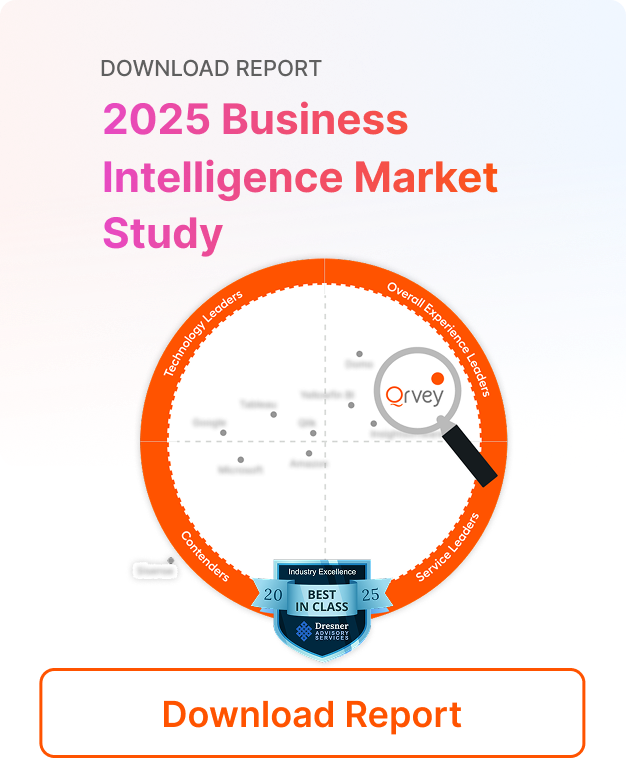
⚡Key Takeaways
- Autonomous analytics leverages AI, machine learning, and automation to analyze data and take action with minimal human intervention.
- It goes beyond traditional BI by enabling real-time insights, automated decision-making, and continuous improvement.
- Core components include AI/ML algorithms, automated data pipelines, feedback loops, and embedded analytics platforms like Qrvey.
- Businesses benefit from faster insights, improved accuracy, scalability, and cost savings—making autonomous analytics a game-changer for SaaS and beyond.
Most organizations face bottlenecks in turning raw data into actionable insights—often relying on manual analysis that’s slow and error-prone. Autonomous analytics is the answer: it uses AI and automation to analyze data, uncover insights, and even execute actions, all with minimal human input. In this article, you’ll learn exactly what autonomous analytics is, how it works, its core elements, use cases, and how to implement it for maximum impact.
What Is Autonomous Analytics?
Autonomous analytics is the next evolution in data analysis, combining artificial intelligence (AI), machine learning (ML), and automation to perform complex analytics tasks and execute decisions—without human intervention. Unlike traditional BI or even SaaS predictive analytics, autonomous analytics can ingest data, generate insights, and trigger actions in real time. Platforms like Qrvey’s embedded analytics are leading this transformation, allowing SaaS companies to deliver smarter, faster, and more scalable analytics experiences. Autonomous analytics is the future of data-driven decision-making, offering unprecedented speed, accuracy, and adaptability.
See how Qrvey’s Embedded AI features work in this video.
How Autonomous Analytics Works
Autonomous analytics follows a multi-stage workflow, transforming raw data into actionable insights and automated decisions. The process starts with data ingestion, followed by processing and cleansing, insight generation, automated decision-making, and a feedback loop for continuous improvement. Each stage leverages AI and automation to maximize efficiency and minimize human intervention.
Stage 1: Data Ingestion
Data ingestion is the foundation of autonomous analytics. Automated pipelines collect data from diverse sources—databases, APIs, IoT devices, and user interactions—ensuring a steady flow of information. This stage is critical for capturing real-time data and enabling timely analysis. Robust ingestion tools reduce manual effort and ensure data quality from the start.
Stage 2: Data Processing & Cleansing
Once data is ingested, AI/ML models clean, normalize, and enrich it. This step ensures consistency, accuracy, and reliability for downstream analysis. Automated processing eliminates errors and biases, making the data ready for advanced analytics. High-quality data is essential for generating trustworthy insights and driving effective automated decisions.
Stage 3: Insight Generation
Advanced algorithms analyze the processed data, uncovering trends, anomalies, and actionable insights—often in real time. Autonomous analytics platforms use predictive and prescriptive models to identify opportunities and risks, enabling organizations to act proactively. Insight generation is continuous, allowing businesses to adapt quickly to changing conditions and market dynamics.
Stage 4: Automated Decision & Action
Based on generated insights, autonomous analytics systems trigger automated actions—such as alerts, workflow changes, or resource allocation—without waiting for human approval. This stage streamlines operations, reduces delays, and ensures timely responses. Automated decision-making empowers organizations to capitalize on opportunities and mitigate risks instantly, driving better outcomes.
Stage 5: Feedback Loop & Continuous Improvement
Results from automated actions are monitored and fed back into the system, creating a feedback loop. This enables models to learn and improve over time, enhancing accuracy and effectiveness. Continuous improvement is a hallmark of autonomous analytics, ensuring that systems adapt to new data, evolving business needs, and changing environments.
5 Core Components of Autonomous Analytics
Autonomous analytics is built on several key components: AI/ML algorithms, automated data pipelines, embedded analytics platforms, feedback loops, and robust security and governance. Each element plays a vital role in enabling continuous insight generation, automated decision-making, and scalable analytics. Together, they create a powerful ecosystem for data-driven organizations.
Component 1: AI/ML Algorithms
AI and machine learning algorithms are the brains of autonomous analytics. They power predictive modeling, anomaly detection, and automated decision-making. These algorithms continuously learn from new data, improving accuracy and relevance. Advanced models enable organizations to uncover hidden patterns, forecast trends, and make smarter, faster decisions with minimal human input.
Component 2: Automated Data Pipelines
Automated data pipelines seamlessly move and transform data from source to analysis. They reduce manual effort, eliminate errors, and ensure data is always up-to-date. Pipelines can handle massive volumes and complex data types, supporting real-time analytics. Efficient data pipelines are essential for scaling autonomous analytics across large organizations and SaaS platforms.
Component 3: Embedded Analytics Platforms
Embedded analytics platforms like Qrvey integrate analytics directly into SaaS products and business workflows. Users access insights where they work, driving adoption and engagement. Embedded platforms offer customizable dashboards, self-service analytics, and real-time reporting. They make autonomous analytics accessible to non-technical users, democratizing data-driven decision-making across the enterprise.
Component 4: Feedback Loops
Feedback loops enable continuous monitoring and learning. Autonomous analytics systems track the outcomes of automated actions, feeding results back into AI/ML models. This iterative process improves accuracy, adapts to new data, and ensures the system evolves with changing business needs. Feedback loops are critical for maintaining relevance and driving ongoing improvement.
Component 5: Security & Governance
Security and governance are essential for protecting data privacy and ensuring compliance. Autonomous analytics platforms implement robust controls, including encryption, access management, and audit trails. Governance frameworks define policies for data usage, quality, and accountability. Strong security and governance enable organizations to trust autonomous analytics and meet regulatory requirements.
How to Implement Autonomous Analytics: Step-by-Step
Implementing autonomous analytics is straightforward with the right approach. Start by defining objectives and KPIs, integrate data sources, deploy AI/ML models, embed analytics in workflows, and set up feedback loops for continuous optimization. Platforms like Qrvey simplify deployment with no-code data analytics, making autonomous analytics accessible to businesses of all sizes.
Step 1: Define Objectives & KPIs
Begin by clarifying your goals—speed, accuracy, cost savings, or new revenue streams. Identify key performance indicators (KPIs) to measure success. Clear objectives guide the implementation process and ensure alignment with business priorities. Involve stakeholders early to build consensus and set realistic expectations for autonomous analytics adoption.
Step 2: Integrate Data Sources
Connect all relevant data sources using automated pipelines. Ensure data is accessible, consistent, and high-quality. Integration is critical for comprehensive analysis and accurate insights. Use tools that support diverse formats and real-time updates. Effective data integration lays the foundation for successful autonomous analytics and drives better decision-making.
Step 3: Deploy AI/ML Models
Select or build AI/ML models tailored to your business needs. Train models on historical data and validate performance. Use platforms that offer pre-built models for common use cases. Deploy models in production and monitor results. Continuous model refinement ensures accuracy and relevance as business conditions evolve.
Step 4: Embed Analytics in Workflows
Integrate analytics directly into business workflows using embedded platforms like Qrvey. Customize dashboards and reports to meet user needs. Enable self-service analytics for non-technical users. Embedding analytics drives adoption, empowers teams, and ensures insights are available where decisions are made. Seamless integration maximizes the impact of autonomous analytics.
Step 5: Monitor & Optimize
Set up feedback loops to track performance and refine models over time. Monitor key metrics, user engagement, and business outcomes. Use insights from feedback to improve data quality, model accuracy, and system efficiency. Continuous optimization ensures autonomous analytics delivers sustained value and adapts to changing business requirements.
5 Benefits of Autonomous Analytics
Autonomous analytics delivers significant business benefits: speed, accuracy, scalability, cost savings, and competitive advantage. Automated analysis provides instant insights, reduces errors, and handles massive data volumes. Organizations save time and money, make smarter decisions, and gain a strategic edge. Autonomous analytics is essential for modern, data-driven enterprises.
Benefit 1: Speed
Automated analysis delivers insights in seconds, not days. Real-time data processing enables organizations to respond instantly to opportunities and threats. Speed is critical in fast-paced markets, where delays can mean lost revenue or missed chances. Autonomous analytics accelerates decision-making, streamlines operations, and keeps businesses ahead of the competition.
Benefit 2: Accuracy
AI/ML models reduce human error and bias, improving decision quality. Automated data cleansing ensures consistency and reliability. Accurate insights drive better outcomes, minimize risks, and support strategic planning. Autonomous analytics continuously learns from new data, refining models and enhancing precision. High accuracy builds trust and confidence in analytics-driven decisions.
Benefit 3: Scalability
Autonomous analytics systems handle massive data volumes and complex queries effortlessly. Scalability is essential for growing organizations and SaaS platforms. Automated pipelines and cloud-based platforms enable analytics to expand with business needs. Scalable solutions support diverse use cases, from customer retention to operational efficiency, without compromising performance or reliability.
Benefit 4: Cost Savings
Less manual work means lower operational costs and higher ROI. Automation reduces the need for expensive data analysts and IT resources. Efficient data processing and real-time insights optimize resource allocation. Cost savings free up budget for innovation and growth. Autonomous analytics delivers measurable financial benefits, making it a smart investment.
Benefit 5: Competitive Advantage
Early adopters of autonomous analytics gain a strategic edge by making smarter, faster decisions. Real-time insights enable proactive responses to market changes. Advanced analytics uncover new opportunities and optimize performance. Competitive advantage drives growth, profitability, and market leadership. Autonomous analytics is a key differentiator for forward-thinking organizations.
Key Use Cases for Autonomous Analytics
Autonomous analytics powers a wide range of real-world applications: customer retention, security monitoring, product personalization, operational efficiency, and revenue optimization. Each use case demonstrates how automated analysis improves performance, decision-making, and business outcomes. Platforms like Qrvey enable organizations to implement autonomous analytics quickly and effectively.
Use Case 1: Customer Retention
Autonomous analytics identifies at-risk customers by analyzing behavior, engagement, and feedback. Automated campaigns target retention efforts, reducing churn and increasing loyalty. Real-time insights enable proactive interventions, improving customer satisfaction. SaaS companies use platforms like Qrvey to monitor retention metrics and optimize strategies, driving long-term growth and profitability.
Use Case 2: Security Monitoring
AI-powered analytics detect and respond to threats in real time, protecting data and systems. Automated alerts and actions mitigate risks before they escalate. Multi-tenant SaaS environments benefit from robust security features and continuous monitoring. Autonomous analytics ensures compliance, safeguards privacy, and maintains trust with customers and stakeholders.
Use Case 3: Product Personalization
Analyze user behavior and preferences to deliver tailored experiences. Autonomous analytics recommends products, content, and features based on real-time data. Personalization drives engagement, satisfaction, and revenue. Embedded platforms like Qrvey enable dynamic customization, empowering businesses to meet individual needs and stand out in competitive markets.
Use Case 4: Operational Efficiency
Automate resource allocation, inventory management, and workflow optimization. Autonomous analytics streamlines processes, reduces waste, and improves productivity. Real-time insights identify bottlenecks and opportunities for improvement. Efficient operations lower costs and enhance service quality. Organizations use autonomous analytics to drive continuous improvement and achieve operational excellence.
Use Case 5: Revenue Optimization
Identify new monetization opportunities and optimize pricing strategies with autonomous analytics. Analyze sales data, market trends, and customer behavior to maximize revenue. Automated actions adjust pricing, promotions, and product offerings in real time. Revenue optimization supports growth, profitability, and competitive advantage, making autonomous analytics a valuable tool for business leaders.
Challenges in Adopting Autonomous Analytics
Adopting autonomous analytics presents challenges: data quality, change management, security, model transparency, and cost. Overcoming these obstacles requires robust tools, clear strategies, and stakeholder buy-in. Pro tips and best practices help organizations address challenges and unlock the full potential of autonomous analytics for business success.
Challenge 1: Data Quality & Integration
Poor data quality undermines analytics accuracy. Invest in robust data pipelines and cleansing tools to ensure consistency and reliability. Integrate diverse sources for comprehensive analysis. Regular audits and validation maintain data integrity. High-quality data is the foundation of effective autonomous analytics and drives trustworthy, actionable insights.
Challenge 2: Change Management
Transitioning to autonomous analytics requires cultural and organizational change. Educate teams, communicate benefits, and start with pilot projects to build buy-in. Address resistance by involving stakeholders and demonstrating value. Change management ensures successful adoption, maximizes impact, and fosters a data-driven culture across the organization.
Challenge 3: Security & Compliance
Protecting data privacy and meeting regulatory requirements are critical. Choose platforms with strong governance features, encryption, and access controls. Regularly review policies and update security measures. Compliance builds trust with customers and stakeholders. Autonomous analytics must balance innovation with responsibility to ensure safe, ethical data use.
Challenge 4: Model Transparency
Opaque AI models can erode trust and accountability. Use explainable AI to clarify decision-making processes. Document model logic, assumptions, and outcomes. Transparency enables users to understand, validate, and improve analytics. Building trust in autonomous analytics is essential for widespread adoption and effective decision-making.
Challenge 5: Cost & Complexity
Implementing autonomous analytics can be costly and complex. Leverage no-code platforms like Qrvey to simplify deployment and reduce expenses. Focus on scalable solutions that grow with your business. Streamline processes and prioritize high-impact use cases. Cost-effective, user-friendly tools make autonomous analytics accessible to organizations of all sizes.
More About Qrvey
Qrvey is redefining how SaaS companies and data-driven organizations harness the power of autonomous analytics. Qrvey is a leading embedded analytics platform designed for SaaS companies. It empowers users to collect, analyze, and act on data—all within their existing workflows. Qrvey’s no-code tools, robust security, and real-time insights make autonomous analytics accessible and scalable.
Businesses use Qrvey to drive customer retention, operational efficiency, and revenue optimization. The platform supports seamless integration, personalized dashboards, and continuous improvement. Whether you’re looking to modernize your SaaS offering, empower your customers, or drive better business outcomes, Qrvey is your embedded analytics and AI partner of choice.

Arman Eshraghi is the CEO and founder of Qrvey, the leading embedded analytics solution for SaaS companies. With over 25 years of experience in data analytics and software development, Arman has a deep passion for empowering businesses to unlock the full potential of their data.
His extensive expertise in data architecture, machine learning, and cloud computing has been instrumental in shaping Qrvey’s innovative approach to embedded analytics. As the driving force behind Qrvey, Arman is committed to revolutionizing the way SaaS companies deliver data-driven experiences to their customers. With a keen understanding of the unique challenges faced by SaaS businesses, he has led the development of a platform that seamlessly integrates advanced analytics capabilities into software applications, enabling companies to provide valuable insights and drive growth.
Popular Posts
Why is Multi-Tenant Analytics So Hard?
BLOG
Creating performant, secure, and scalable multi-tenant analytics requires overcoming steep engineering challenges that stretch the limits of...
How We Define Embedded Analytics
BLOG
Embedded analytics comes in many forms, but at Qrvey we focus exclusively on embedded analytics for SaaS applications. Discover the differences here...
White Labeling Your Analytics for Success
BLOG
When using third party analytics software you want it to blend in seamlessly to your application. Learn more on how and why this is important for user experience.








